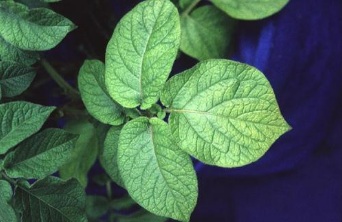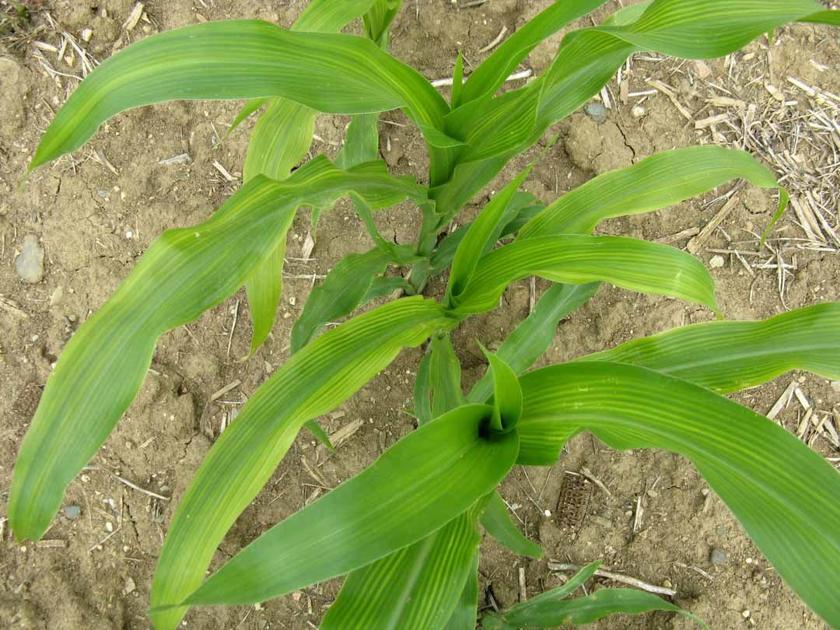Published May 19, 2020 | By Mike Petersen
Image Above:
Early season sulfur deficiency, V5 stage
Sulfur one of the secondary nutrients in crops carries out some very important functions in the plant growth cycle from early emergence to starch fill in grain. Even though it is pretty well known that sulfur (S) is mobile in the soil, it is not in a plant’s vascular system – the lower sets of leaves will not show deficiencies of S as much as the upper/newer leaves will depict a yellowing appearance. Do not misdiagnose that yellowing a lack of nitrogen (N), if that happens folks tend to think more N will solve it – no sir, usually creates more of a sulfur problem especially late in the crop’s life cycle. Sulfur does not transfer from older growth into the new leaves. With reason then late applications of S when diagnosed properly can be a great help in yield and plant-grain function. Usually a foliar and soil feeding will do the trick.
What is the function of S in the plant?
Dan Davidson who I have known for more than 15 years, writing for the Illinois Soybean Growers, reports that sulfur and nitrogen work complimentary to one another. Sulfur is a component of specific amino acids in the photosynthesis processes and seed production: methionine, cysteine and cystine.
He went on to say; “Sulfur is a component of numerous enzymes (proteins) that regulate photosynthesis and nitrogen fixation and assimilation by the plant. It’s a component of ferredoxin, an iron-sulfur protein found in the chloroplasts—the site of photosynthesis. Ferredoxin also plays a metabolic role in both nitrogen fixation and sulfate reduction and the assimilation of nitrogen by rhizobacteria living in the nodules in soybeans”.
One of the important enzymes that drive nitrogen fixation is nitrogenase. This enzyme contains considerable amounts of sulfur and converts atmospheric nitrogen to ammonia. In addition Ferredoxin acts as an electron transfer agent in both nitrogen fixation and nitrogen assimilation into protein found in legume production like soybeans.
When does sulfur become available via the microbial breakdown of the organic sulfur components in soils organic matter (SOM)?
The activation of S is very dependent upon soil temperature and soil moisture. Both air and soil temperature below 50°F (10°C) is very minimal. Oxidation of the SOM really kicks in gear between 75-85°F [23-29°C] which says this importance nutrient for photosynthesis production, enzymes, and proteins is not happening in the upper 8 inches of the soil profile until early to mid-June in the Northern hemisphere. A short list of who in the soil (bacteria) that oxidize S to become Sulfate (SO4) for the plant to utilize it directly: Chlorodium spp., Chlymydiaceae spp., Cytophaga spp., Flavobacterium spp., Porphytomonas spp., Prosthecobacter spp., Rubritaleaceae spp., Bacteriodes spp., Candidatus spp., Chthoniobacteria spp., and Fucophilus spp. As I indicate with the spp, we are looking at multiple species within the two genuses of Chlymydiaceae and Candidatus for instance. Please I am not trying to slap a big number of genus and species names to tie your tongue and sound like I am so smart with microbiology. The number of bacteria in the soils both anaerobically and aerobically is large and their function oxidizes carbon rich compounds in residues and SOM and provides Sulfates available to the plant root. For example; most obvious to anyone who has dug around in a mucky soil near a cattail mud hole know about the sulfidic odor [hydrogen sulfide] that on a hot summer day can make you nearly gag – those are anaerobic bacteria – some 23 genera, 220 species are known of the Deltaproteobacteria order; the second most is in the facultative-anaerobes of Firmicutes. All in all these bacteria are important to take SOM and make SO4 available to a plant.
Therefore an important point to make here, sulfur coming available via bacteria in the soil and some mycorrhizae does not start right off the bat. The need of sulfur within the first 40 days after emergence is high and we can help that hungry growing plant function better and improve yield potential by adding S via the spring pre-plant and in the starter products. Couple of examples: Soybeans remove 1.7-2.0 lbs. per 10 bushels of grain at a 60 bu/ac yield or 10-12 lbs/acre in a season, then corn removes 0.5lb per 10 bushels of grain or requires 30-35lbs/acre in a season. Of those noted needs sulfur from V10 to hard doe stage R3-R4 in corn is over 60% of the plants total requirement of sulfur. The soils are at their maximum of temperature extension at V14-R1 into the soil profile. Soil temperature in the upper 10 inches (25cm) is reaching even under full canopy 85-88°F [29-31°C] and the soil bacteria are turning over nutrients in the SOM every hour of the day.
Image 2:
Sulfur deficiency in soybeans
In continuous corn fields the amount of S in the residues is not that great so a smart/wise nutrient management plan begins in a strip till system right as one strip tills to planting time and then during the rest of the season. We here at Orthman advocate tissue sampling to best identify what is happening in the growing crop. From information back in 2017 from a Purdue University Soil Fertility Update, the good folks at Purdue suggested; In the plant, S is a component of two amino acids and occurs in protein in a ratio of 1 part S to about 15 parts N. Therefore, the N:S ratio of plant tissue as well as the S concentration are used to identify S deficiency. The lower the S concentration and the higher the N:S ratio the more likely S is deficient in the plant. Tissues from corn as you look at sulfur less than 0.15% and N:S ratio greater than 20:1 are most likely S deficient. Sulfur is most likely adequate when corn tissue S is greater than 0.20% and the N:S ratio is less than 12:1. Tissue S and N:S values in between these levels can go either way – deficient or adequate. Critical tissue S levels for soybean have been studied much less than for corn. Typically 0.2-0.3% S is considered adequate. This kind of information can really be helpful in determining the S health of your plants and what to do about it.
Knowing that a good amount of sulfur prior to 2007 came from atmospheric deposition, mainly from coal-fire generating plants. Good scrubbing techniques of the exhaust stacks have changed that but our plants have lost that input. In fact there are power plants that offer the cleanings as a fertility source of sulfur for very little money per ton. Higher yielding hybrids have shown us the demand for S, so we must watch our all-season nutrient program. It is our belief to bring this up before your eyes and know that Orthman is capable of helping your deliver nutrients to your crops via the 1tRIPr, cultivators, and in-crop fertilizer soil insertion applicators.
Stay tuned as we keep exploring, offering tools, recent information and knowledge of nutrients, their function, how to get products applied.

